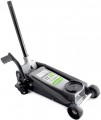Load capacity
The maximum weight the jack can lift. The perfect option is considered to be such a carrying capacity that exceeds the weight of the car (or other load lifted by the jack). At the same time, do not forget that the load on the jack usually does not have to be lifted entirely, one side of it is most often on the ground. This means that only part of the mass falls on the jack, and the maximum load may well be somewhat less than the total weight of the car being lifted: for example, for a one and a half ton passenger car, a 1 ton model is considered quite sufficient. For each class and weight category of machines, there are rules for choosing jacks according to the minimum load capacity; More details about these rules can be found in special sources.
Max. lifting height
This parameter shows to what maximum height the jack can lift the load. Usually, on average, this parameter is in the range from 30 to 50 cm, which is quite enough to change the wheel or access the handbrake cable. At the same time, rack jacks are capable of lifting loads to a height of up to 1 metre, although such tasks do not occur so often in domestic use.
Quick-lift pedal
The presence of a
quick lift pedal in the design of the jack.
When you press such a pedal, the jack platform rises with minimal effort, but at high speed. This relieves the user of the need to pump up the jack "idle": by pressing the pedal, the working platform quickly covers the distance to the lower edge of the load, and you need to pump the handle only in the process of lifting itself, without wasting time and effort on free running. The pedal is mainly equipped with rolling models (see "Type") of a professional level.
Case included
The presence of a
case in the delivery set of the jack. Own case facilitates storage and transportation of the instrument, while being much more convenient and reliable than impromptu packaging.

